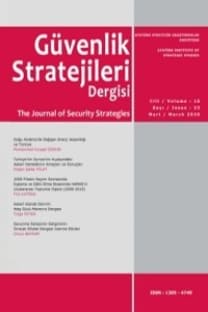Eş Anlamlı Değil ama Eş Kullanımlı: Muharebe Sahası Fonksiyon Alanları Çerçevesinde Konvansiyonel, Asimetrik ve Hibrit Savaş
Uluslararası Güvenlik, Muharebe Sahası Fonksiyon Alanları, Konvansiyonel Harp, Düzensiz Savaş, Kavramsal Analiz
Not Synonymous, but Substitutional: Conventional, Asymmetric, and Hybrid Warfare within the Framework of Battlefield Functions
International Security, Battlefield Functions, Conventional Warfare, Irregular Warfare, Conceptual Analysis,
___
- HERMAN Paul F. (1997). “Asymmetric Warfare: Sizing the Threat”. Low Intensity Conflict & Law Enforcement, 6:1, 176-183.
- HOFFMAN Frank G. (2007). Conflict in the 21st Century: The Rise of Hybrid Wars, Potomac Institute for Policy Studies, Arlington, Virginia.
- JTS (1997). CINC/JTF Joint Targeting Organizations and Architecture. Joint Targeting School. Dam Neck AB, VA.
- KELLY Charles M. (2020). “Information on the Twenty-First Century Battlefield: Proposing the Army’s Seventh Warfighting Function”, Military Review, 100:1, 63-68.
- KILCULLEN David (2005). “Countering Global Insurgency”, Journal of Strategic Studies, 28:42, 597-617.
- KÖRPE Özgür (2022). Maske ve Keleş: Düzensiz Savaşa İlişkin Sorular ve Cevaplar, Yeditepe Yayınevi, İstanbul.
- METZ Steven ve JOHNSON Douglas V. (2001). Asymmetry and US Military Strategy: Definition, Background, and Strategic Concepts, Strategic Studies Institute, Pennsylvania.
- MONAGHAN Sean (2019). “Countering Hybrid Warfare So What for the Future Joint Force?”, Prism, 8:2, 82-99.
- SMFLS5 (2021). The Sustainment & Multifunctional Logistics Smartbook. Fifth Edition, Lightning Press, Lakeland, FL.
- Türk Silahlı Kuvvetleri (1992). MS 76-3 TSK Müşterek Askerî Terimler Sözlüğü (Mülga). Genelkurmay Basımevi, Ankara.
- Von CLAUSEWITZ, Carl (1999). Savaş Üzerine, (çev. H. Fahri Çeliker), Özne Yayınları, İstanbul.
- US Army (2010). “TC 7-100 Hybrid Threats”, Headquarters Department of Army, https://armypubs.army.mil/epubs/DR_pubs/DR_a/pdf/web/tc7_100.pdf, erişim 07.08.2023.
- US Army (2020). “The U.S. Army Concept for Maneuver in Multi-Domain Operations, 2028-2040”, https://apps.dtic.mil/sti/pdfs/AD1118627.pdf, erişim 07.08.2023.
- US DoD (2008). “Directive Nr. 3000.07 Irregular Warfare (IW)”, U.S. Department of Defense, https://irp.fas.org/doddir/dod/d3000_07.pdf, erişim 11.07.2023.
- US DoD (2021). “AFC Pam 71-20-6 Army Futures Command Concept for Fires 2028”, U.S. Department of Defense, https://api.army.mil/e2/c/downloads/2021/10/06/ 869ca62b/afc-concept-for-fires-2028-oct21.pdf, erişim 14.06.2023.
- US Army (2022). “FM 5-0 Planning and Orders Production”, Headquarters Department of Army. https://armypubs.army.mil/epubs/DR_pubs/DR_a/ARN36775-FM_5-0-001-WEB-3.pdf, erişim 13.08.2023.
- US Army (2017). “FM 3-0 Operations”, Headquarters Department of Army, https://armypubs.army.mil/epubs/DR_pubs/DR_a/ARN36290-FM_3-0-000-WEB-2.pdf, erişim 09.05.2023.
- ISSN: 1305-4740
- Yayın Aralığı: 3
- Başlangıç: 2005
- Yayıncı: Millî Savunma Üniversitesi Atatürk Stratejik Araştırmalar ve Lisansüstü Eğitim Enstitüsü
Doğu Cephesinde Yeni Bir Şey Yok: Rusya-Ukrayna Savaşı Sonrası Avrupa’da Savaş Hazırlıkları
Hukuk Savaşımının Kavramsal Çerçevesi ve Uygulamaları Üzerine Bir İnceleme
Ordular Sadece Savaşır mı? Yeni Görevler Bağlamında Türkiye, ABD ve Rusya Orduları
Savaşı Dersliklere Taşımak: Akademide Savaş Oyunlarından Nasıl İstifade Edilebilir?
Özel Sayı Takdimi: “Yeni” Savaşlar ve “Yeni” Ordular
Askerî Gücün Savaş Dışı Kullanımı: Afganistan ve Irak’ta Kolluk İstikrar Harekâtı
“Yeni Nesil” Savaşın Şafağında Teknoloji Perspektifinden Deniz Harbinin Gelişimi
Geleceğin Savaşlarında Yapay Zekâ
Türk Ordusunda Ast Kademe Komuta İhtiyacı: Küçük Zabitlikten Astsubaylığa
